
Patients who undergo procedures that result in IV lines or ports know that they must be careful with the new line. Doctors will advise patients on how to take care of these ports and what precautions to take when performing everyday activities.
One of the most important aspects of managing a port or line after surgery is keeping it waterproofed. If water or other liquids seep into the line, infections could occur or the liquids could mix with the IV medicine, resulting in major health problems.
Waterproofing dialysis ports and PICC lines is vital for patients who have them. With the right precautions and the right materials, it can be done and regular activities can be enjoyed without a problem.
In this article, we’ll discuss the problems and solutions relating to waterproofing dialysis ports and PICC lines.
Important notes for handling midlines, ports, and PICC lines
As you would expect, keeping midlines, ports, and PICC lines clean and dry is very important. Doctors will typically provide wound dressings that will absorb any liquids that come near these lines. Securing these wound dressings with Hy-Tape can ensure a waterproof seal without skin irritation.
Patients must avoid submerging a line in water for any amount of time. This can quickly soak a wound dressing, leaving no defense against water seeping into the line and causing health issues. Only very well-dressed, sealed lines can handle occasional submerging for short periods.
If wound dressings do become soaked, it’s important to leave them in place and consult a doctor for replacement. These dressings need to be removed carefully and the area properly dried before a fresh wound dressing can be placed.
PICC and Midline vs. Hickman or Port lines
There are a few common types of lines a patient may have installed during surgery, all of which need to be taken care of and kept away from water. They are:
- PICC lines – Typically an insertion point in the arm
- Midline – Typically an insertion point in the arm
- Hickman / Port lines – Typically located in the chest
Depending on the patient and their regular activities, these lines may cause more or fewer issues for one person compared to the other. The lines usually need to be connected to a pump to deliver medicine or remove liquid and can’t be disconnected for very long. They must also be kept as dry as possible at all times, requiring an absorbent wound dressing and a tight-holding tape such as Hy-Tape for security against water.
Tips for waterproofing PICC lines and midlines
Waterproofing PICC lines can be done with a variety of strategies. Many doctors recommend the following for those who need to waterproof PICC lines or midlines:
- Wrap the area with cling wrap – Common, store-bought cling wrap offers a waterproof seal when applied correctly. It can be wrapped around the arm and sealed with light pressure.
- Use a PICC line shower cover – Specially designed for PICC lines, these sleeve-like covers feature two rubber ends that seal out water. They can be found at medical shops online and they are reusable.
- Use a long plastic bag – Similar to a shower cover, a variety of long plastic bags can be used for waterproofing PICC lines. Cut a hole in the bottom of a bag to create a sleeve-like bag, then reach through to cover the arm. Tie the plastic bag off with rubber bands or seal with Hy-Tape to keep water out.
Most strategies for waterproofing PICC lines require assistance from another person, so any patient with a PICC line or midline should have a friend or family member available to ensure a waterproof seal over their line.
Read: PICC Lines – Waterproofing, Securement, Skin Reactions
Tips for waterproofing dialysis ports or Hickman ports
Waterproofing dialysis ports is similar to working with PICC lines or midlines. Here are a few tips for keeping dialysis ports waterproof:
- Wrap chest in cling wrap – Much like PICC lines and midlines, cling wrap is a great option for waterproofing. Wrap the chest with cling wrap over one shoulder and under the other arm until a few layers cover the port.
- Use a waterproof cover – Large, sticker-like coverings can be carefully placed over a dialysis port and sealed at the edges to keep out water. Be sure to carefully remove these after a shower so as to not disturb the port.
Hy-Tape is the best tape for securing these covers when waterproofing dialysis ports. The tape is designed to be sensitive to the skin both when being applied as well as when being removed. The zinc-based material also features fewer skin irritants than other common medical tapes.
Hy-Tape provides peace of mind that the covering over a dialysis port is truly as waterproof as possible.
Read: Kidney Dialysis Catheter: Caring for the Site
Tips for handling pump devices
Pump devices must also stay clear from water sources to ensure proper function. Many patients are able to place their pump device inside a separate bag and hang it on a hook in the shower or bath to keep it out of the water. Some also bathe with a showering wand to gain extra control over where the water will spray, keeping water away from the pump.
Sealing a pump device inside a thick, waterproof bag may be the best option, although typical bags may not seal tightly enough. Adding Hy-Tape can seal the bag completely, ensuring that no water can pass through at the sealed point. For those with skin sensitivities, Hy-Tape’s zinc-oxide formula is designed to cause little to no irritation.
Be sure to properly secure your PICC lines, midlines, or dialysis ports before getting anywhere near a source of water. With the right wound dressing sealed with Hy-Tape, you can rest easy knowing that your port is waterproofed.
Read: Preventing Skin Reactions to Continuous Glucose Monitors and Insulin Pumps
Read: Managing Insulin Pump and Insulin Pod Adhesive Allergy

